- Changes in U.S. digital asset policies seem to have enhanced institutional confidence in the industry, leading to increased mergers and acquisitions, stablecoin and asset tokenization investments, and other strategic investments in March.
- Although cryptocurrency valuations slightly decreased this month and remain low year-to-date, industry fundamentals have improved. Despite being a unique alternative asset class, cryptocurrency valuations are still influenced by changes in macroeconomic prospects and fluctuations in investor risk appetite.
- The prospects for tariffs and other government policies remain uncertain. However, weaker economic prospects have been partially priced in by the market, and we do not anticipate severe government spending cuts, comprehensive trade wars, or economic recession. Therefore, Grayscale Research continues to be optimistic about the fundamental prospects of the cryptocurrency market.
- For investors who have not previously invested in cryptocurrencies, we believe the valuation decline since early 2025 provides an attractive potential entry point for establishing a long-term asset allocation.
In March 2025, cryptocurrency valuations slightly declined, but the month also showed signs of accelerating institutional activity—marking a continuation of a series of events since the U.S. November election. After recent changes in U.S. crypto policies, institutions appear confident about medium-term prospects and have begun making substantial investments in the digital asset industry.
In March, our market-cap-weighted crypto asset classification index dropped 5%, while Bitcoin's price fell by 2% (Chart 1). Traditional assets faced similar challenges: U.S. stocks weakened, led by large tech and cyclical stocks; global fixed-income markets also had negative total returns. Meanwhile, the U.S. dollar depreciated against the euro and gold. Historically, Bitcoin's price has shown a positive correlation with broad stock indices and a negative correlation with the dollar's value. Therefore, the combined performance of crypto assets declining with the stock market and a weakening dollar in March generally aligns with historical correlation patterns.
Chart 1: Crypto Asset Valuations Essentially Flat in March
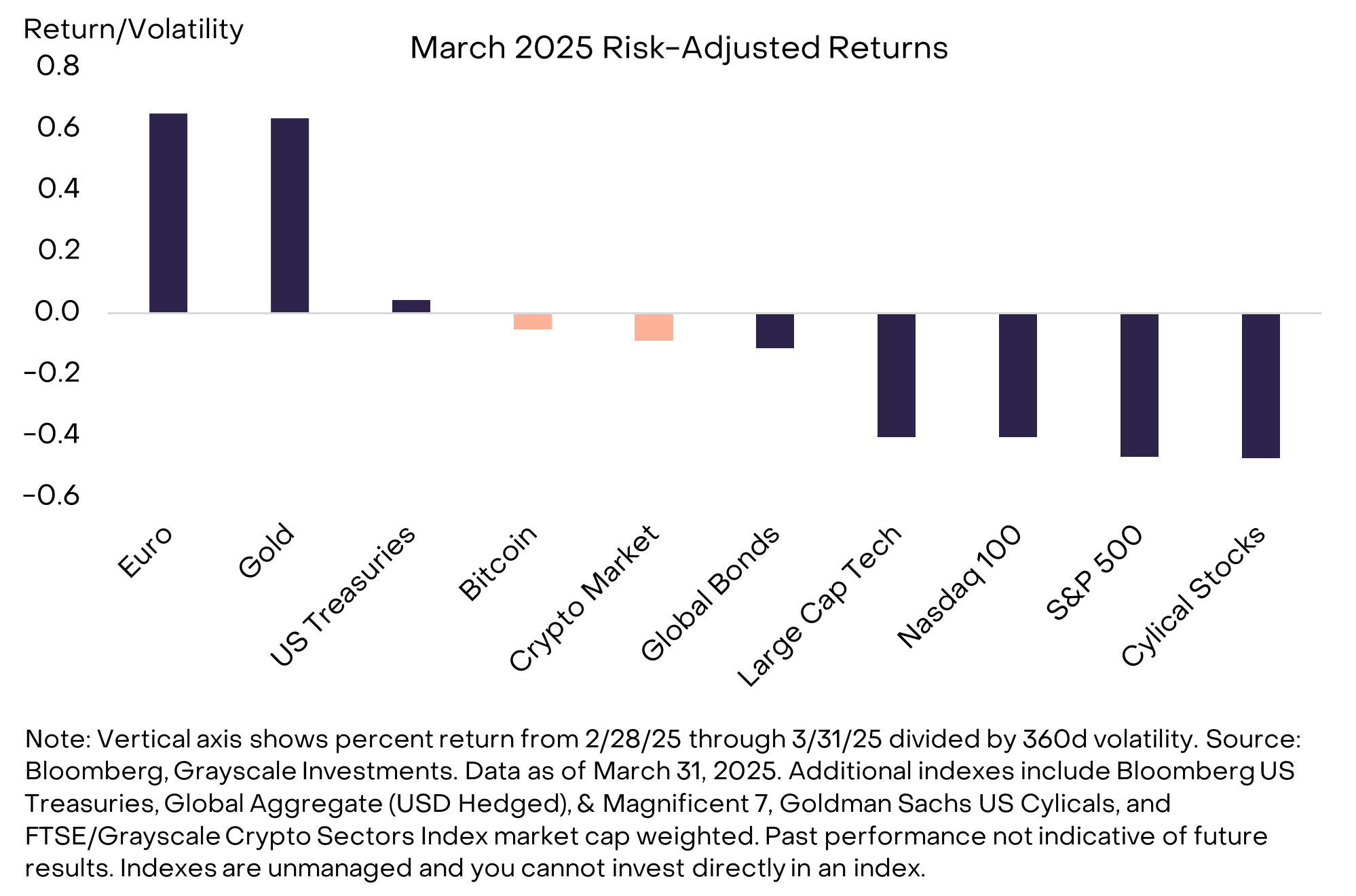
Growing Conviction
While March was relatively calm from a valuation perspective, the dense news of institutional dynamics highlights the profound transformation occurring in the digital asset industry.
First, Trading Activity Heats Up
Crypto exchange Kraken announced the acquisition of futures trading platform NinjaTrader for $1.5 billion—the largest M&A transaction in the crypto industry to date. This move will enable Kraken to offer regulated crypto futures and other derivatives in U.S. and international markets. Simultaneously, Bloomberg reports that Coinbase is in deep negotiations to acquire Deribit, the leading crypto options trading platform, with the transaction potentially being even larger based on Deribit's recent valuation.
Over the past two quarters, Grayscale Research estimates (based on Messari data) that total financing in the crypto industry has reached approximately $10 billion, significantly up from $3.5 billion in the previous two quarters (Chart 2). This month also saw several large venture capital investments, including Sequoia Capital and others injecting $400 million into the TON Foundation, and Abu Dhabi's sovereign wealth fund MGX investing $2 billion in Binance.
Chart 2: Financing Activity Accelerates Post-U.S. Election
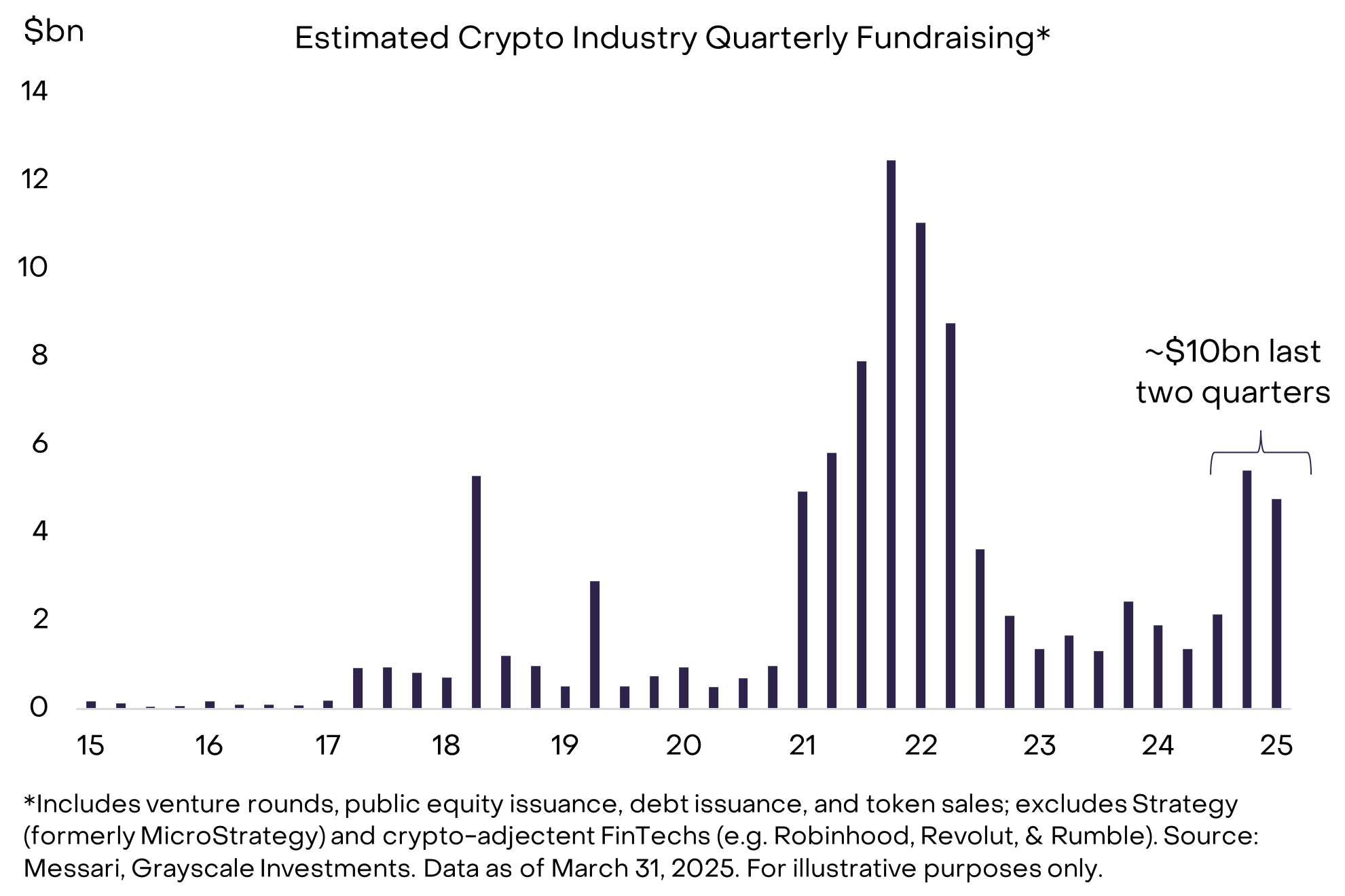
Second, more institutions are entering the space before potential stablecoin legislation by the U.S. Congress this year (see Chart 3). For example, media reports suggest that Fidelity and World Liberty Financial, associated with the former president, plan to launch USD-backed stablecoins. Several major fintech companies have also positioned themselves in the stablecoin business—payment technology provider Stripe announced the acquisition of stablecoin infrastructure company Bridge last year, which was completed this February. Similarly, PayPal launched its own stablecoin PYUSD in August 2023 (current market cap around $725 million), with reports indicating that Revolut plans to issue a stablecoin in the future (in addition to stablecoins, the platform also opened crypto trading applications to mobile users last month).
Chart 3: U.S. Congress May Advance Stablecoin Legislation
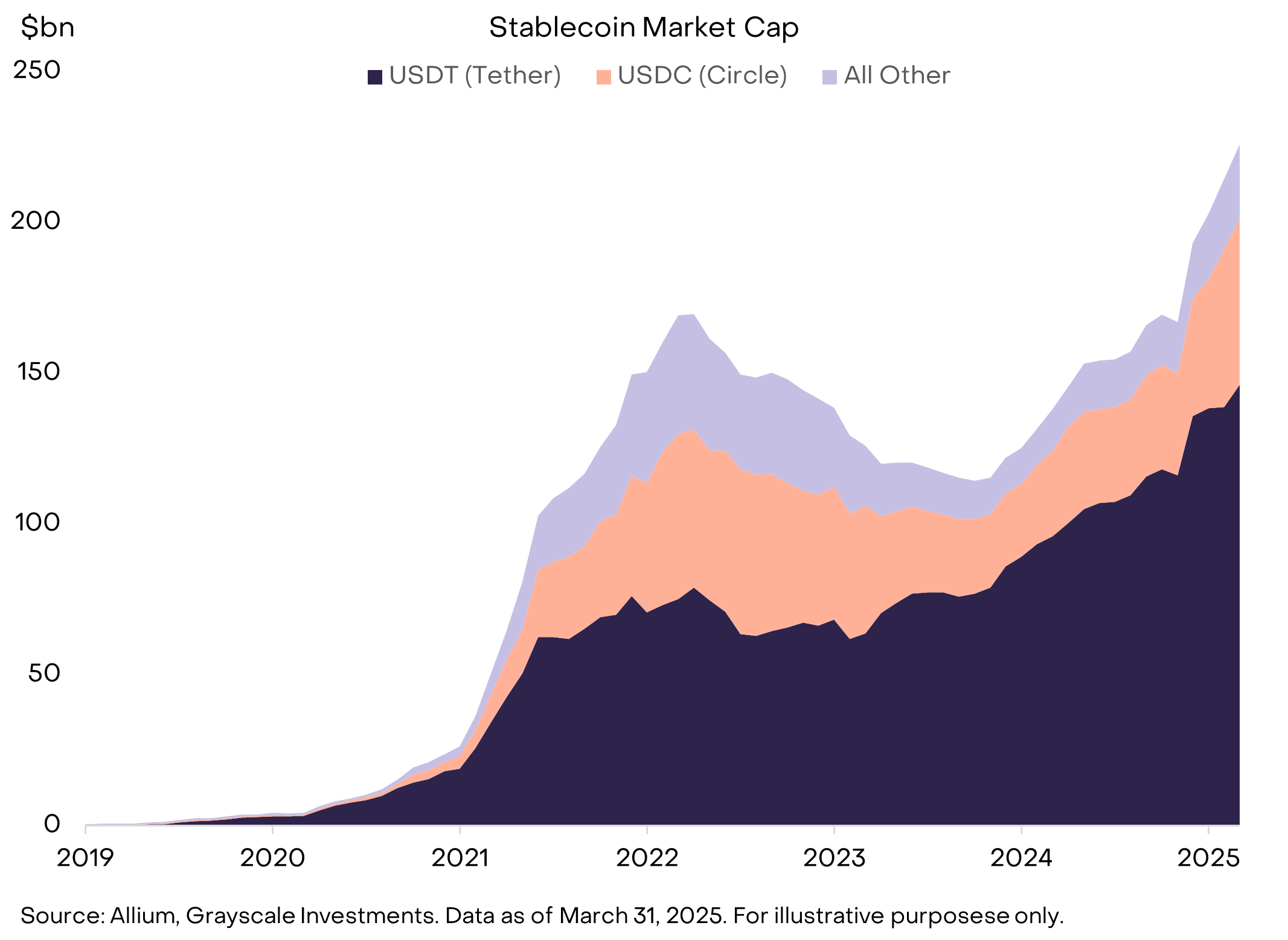
Third, the tokenization of real-world assets (RWA) is gaining momentum (background information can be found in the "Public Blockchain and Token Revolution" report). According to data platform RWA.xyz, the total scale of non-stablecoin tokenized assets reached a historical high of $19.5 billion in March (Chart 4). This growth primarily stems from the expansion of BlackRock's tokenized government bond product BUIDL, whose scale is approaching $2 billion. The growth of tokenized assets may drive demand for "institutional-grade DeFi" applications, and recent industry dynamics also show that related infrastructure is attracting capital. For instance, Coinbase announced the creation of a "verification pool" (essentially a decentralized exchange architecture with identity verification), and Securitize partnered with Ethena to launch a blockchain network providing "compliant access" for DeFi.
Chart 4: Tokenized Asset Scale Reaches New High
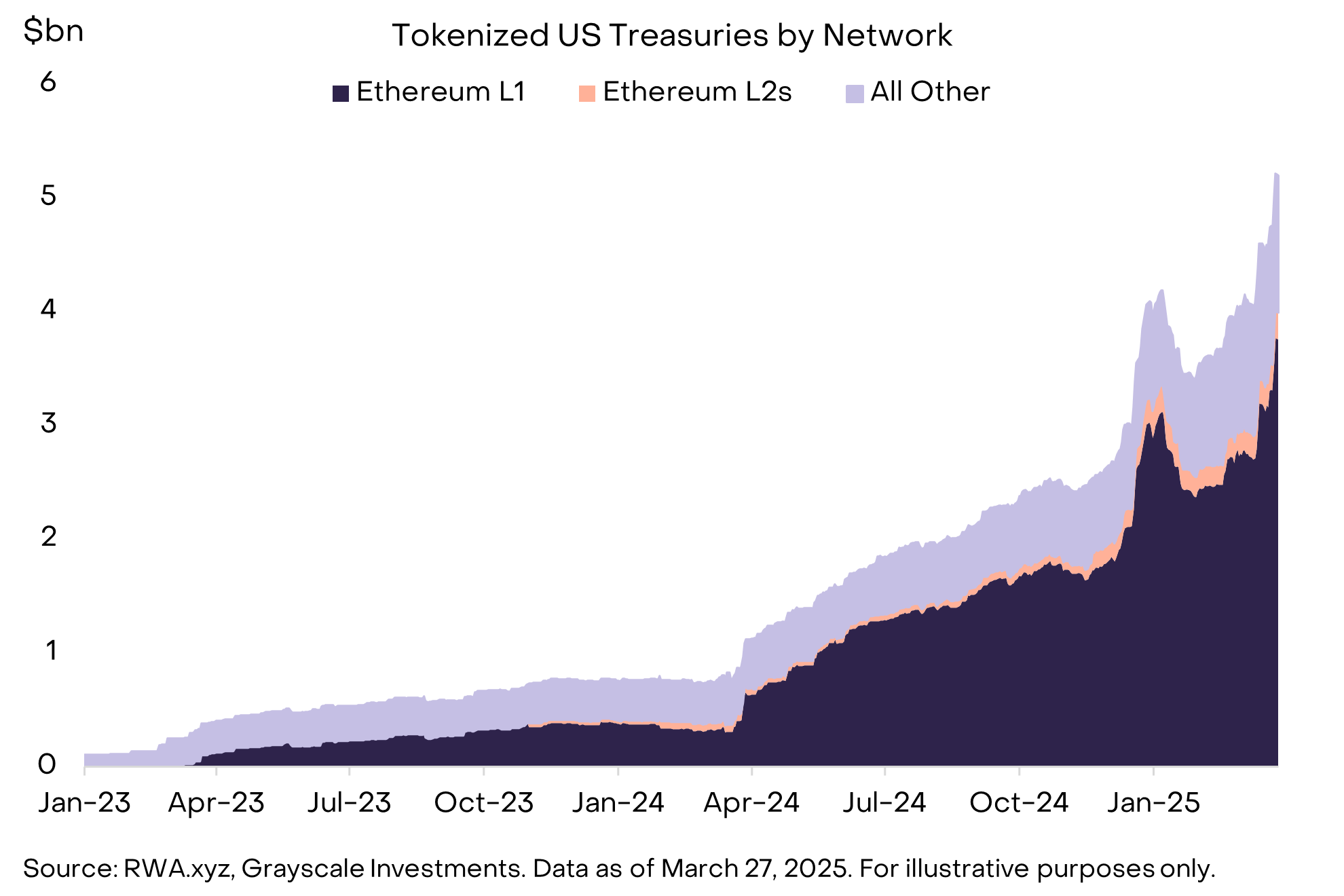
Fourth, an increasing number of companies are incorporating Bitcoin into their balance sheets. MicroStrategy (formerly MicroStrategy) is a pioneer in this approach, purchasing an additional 29,000 Bitcoins (approximately $2.4 billion) in March 2025. Since announcing its current purchase plan in November last year, it has accumulated over 275,000 Bitcoins (approximately $23 billion). Many Bitcoin mining companies now choose to retain Bitcoin on their balance sheets (and even buy in the open market). The largest Bitcoin-holding mining company, MARA, added 715 Bitcoins (approximately $60 million) last month and initiated a $2 billion equity financing plan to provide funds for future purchases.
Other recently announced Bitcoin purchasers include video-sharing platform Rumble and energy storage company KULR. In late March, game retailer GameStop stated that its board has approved Bitcoin as a reserve asset.
Last but not least, the U.S. established a "Strategic Bitcoin Reserve". In the executive order issued on March 6, President Trump created this reserve partly because "being among the first countries to view Bitcoin as a reserve asset provides a strategic advantage". The order requires all Bitcoins held by government agencies to be transferred to this reserve and stipulates that they "must not be sold", while also requiring the Treasury Secretary and Commerce Secretary to "develop strategies for increasing Bitcoin holdings". Additionally, the executive order created a "Digital Asset Reserve" for holding (and potentially liquidating) crypto assets other than Bitcoin, and mandated that government agencies conduct a comprehensive inventory of their digital assets. It is estimated that the U.S. government currently owns 103,000 Bitcoins ($8.7 billion) and approximately $400 million in other digital assets.
The establishment of the Strategic Bitcoin Reserve initially disappointed some market participants as it did not immediately purchase Bitcoin in the open market. However, we believe this view is short-sighted. Viewing Bitcoin and public blockchain technology as strategic assets may compel other countries to reevaluate their crypto industry policies, thereby accelerating global adoption. Of particular interest is China—currently prohibiting cryptocurrency trading and mining activities but allowing crypto asset ownership. However, under the "one country, two systems" framework, crypto-related activities in Hong Kong have received policy support. Notably, the Chinese Supreme Court discussed the legal handling of crypto assets in February this year, suggesting that regulators might reconsider the legal status of digital assets. If China relaxes crypto restrictions, it would significantly promote Bitcoin's global adoption.
Addressing Macro Risks
Although cryptocurrency fundamentals seem to be improving, our market-cap-weighted crypto industry index shows a decline of approximately 30% year-to-date. Cryptocurrencies are a unique alternative asset class with relatively low correlation to stock returns, but the market is still influenced by broad changes in macroeconomic prospects and/or investor risk appetite.
Policy Changes Trigger Market Fluctuations
Recent market volatility primarily stems from adjustments in U.S. government policies. In the coming years, policy decisions implemented by the Trump administration will have broad economic implications, many of which could positively impact productivity growth, domestic employment, and corporate profits. However, the White House's choice to prematurely implement certain policies—including immigration restrictions, government spending cuts, and tariffs—may negatively affect economic output in the short term. Consequently, economists have begun to lower GDP growth expectations for this year, and publicly traded companies have similarly reduced their earnings guidance. The deterioration of short-term prospects has triggered significant global stock market pullbacks and broader risk aversion, ultimately dragging down Bit and other crypto assets (see Figure 5).
Figure 5: Bit and Stock Market Decline Synchronized in Q1 2025
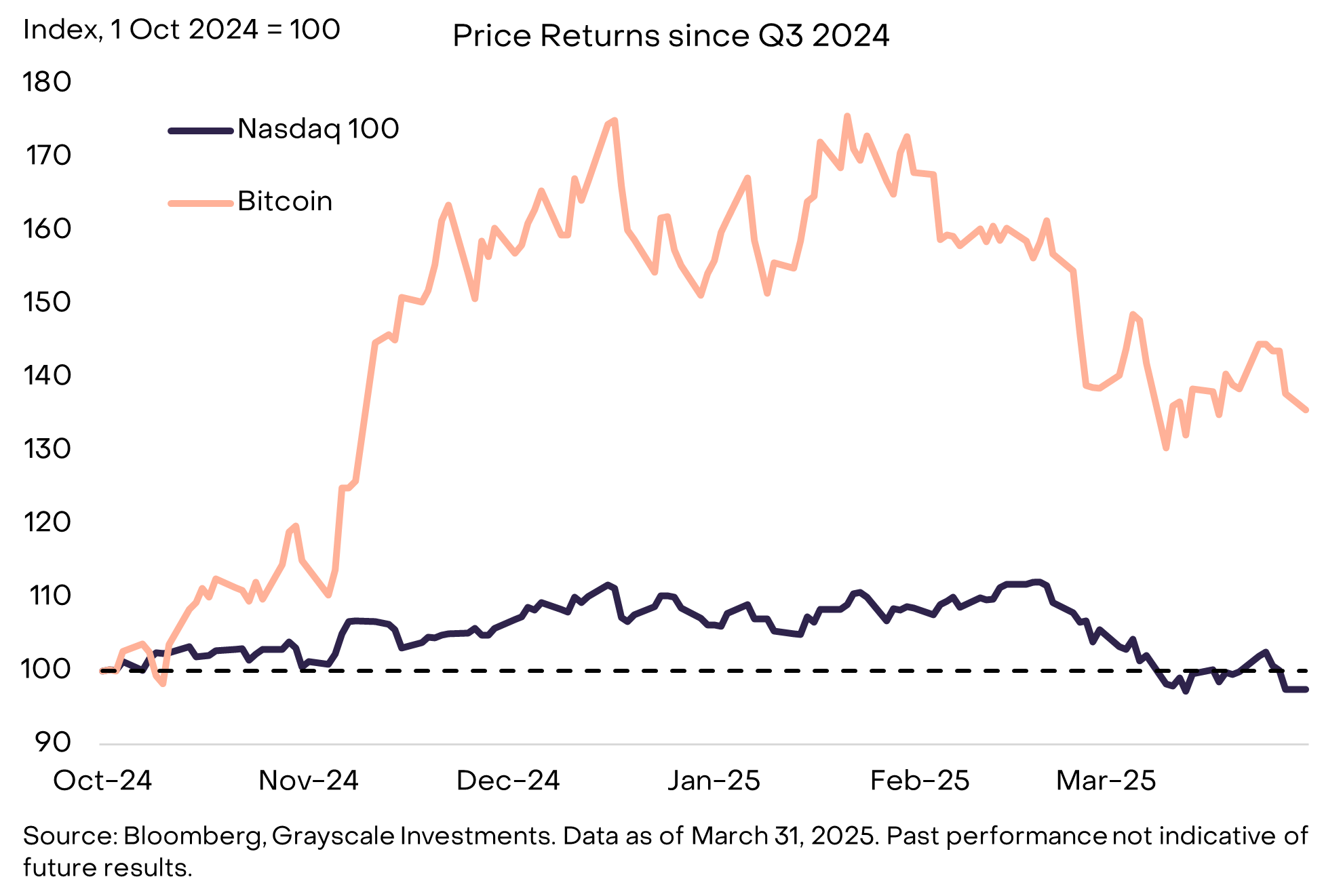
U.S. policy prospects remain highly uncertain in the short term, thus the crypto market continues to face macroeconomic risks. However, the market has already significantly repriced, so the drag of tariffs on economic growth should at least be partially absorbed. For instance, since mid-December's peak, the "Magnificent Seven" stocks' market value has shrunk by over $3 trillion (an amount exceeding the total market capitalization of the entire crypto asset class).
Moreover, the potential short-term downward economic growth risk from the U.S. government efficiency department (DOGE) spending cuts might be overestimated. The agency claims to have saved $130 billion (0.4% of GDP), but most must be deferred payments, and there's no evidence that the Treasury has reduced payments—in fact, current tracking data shows total government spending this year is higher than 2023 and 2024 levels (Figure 6). Significant government spending cuts might be incorporated into the budget reconciliation bill progressing in Congress, but it's currently unclear how much reduction could garner sufficient support.
Figure 6: Almost No Evidence of Reduced Government Spending
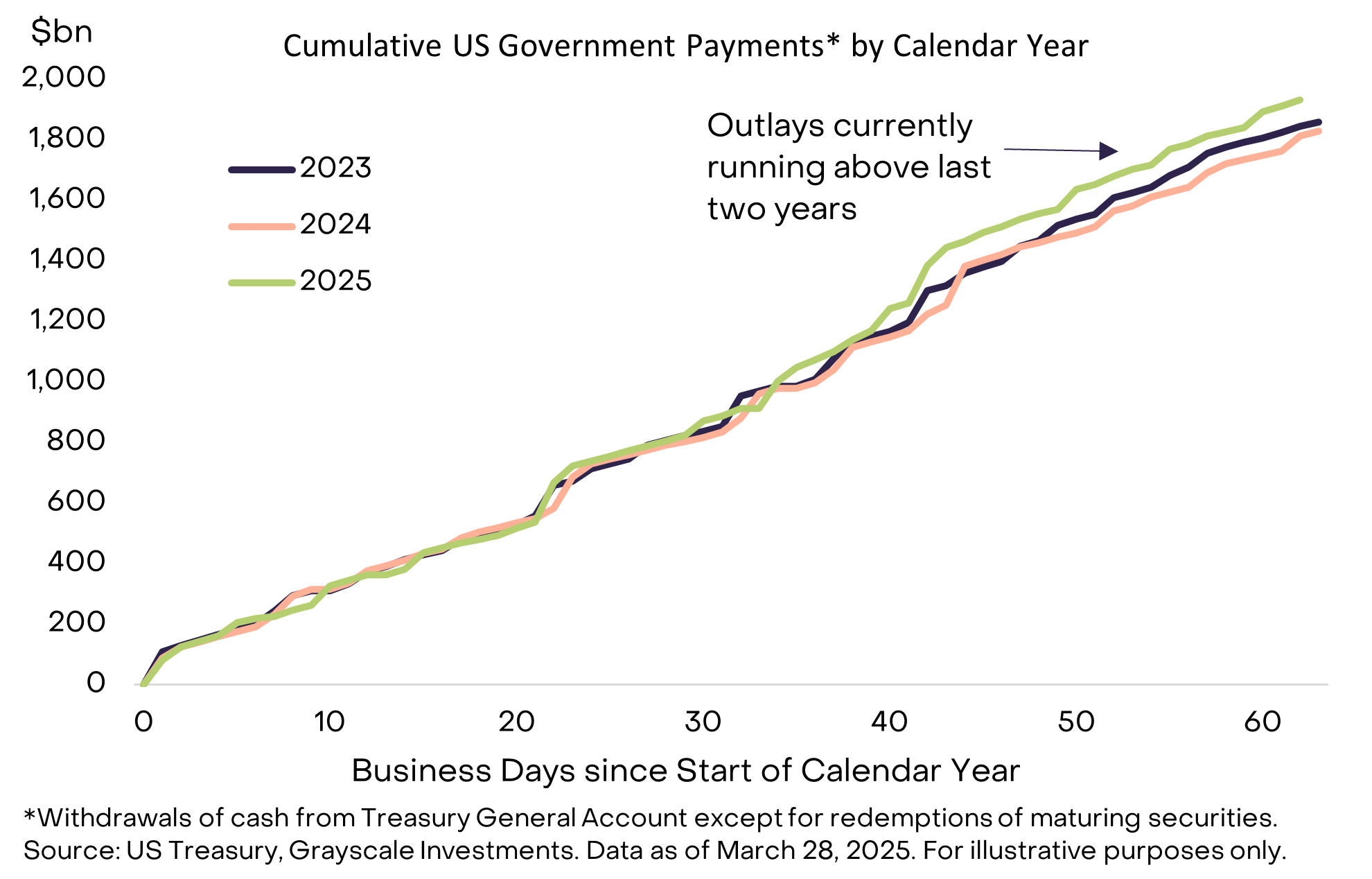
Therefore, Grayscale Research maintains an optimistic baseline outlook for the crypto market, grounded in both the favorable fundamental trends of the digital asset industry and the overall supportive macroeconomic environment. Should an economic recession occur due to trade wars, significant government spending cuts, or other factors, crypto asset valuations might face further pressure. However, if policy uncertainty decreases and the economy remains resilient, crypto asset valuations could rapidly rebound, considering the recent market pullback and solid industry fundamentals. For investors who have not yet allocated crypto assets, the valuation decline since early 2025 may offer an attractively timed entry point for establishing long-term positions.








